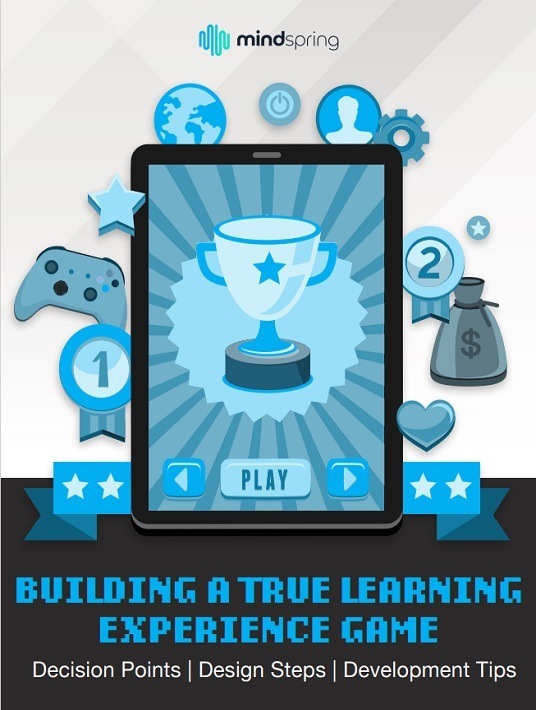Spark Friendly Competition To Increase Learner Motivation And Simplify Subject Matter
This article is part of a series on building a true game to increase managers’ understanding of corporate finance. What you are about to read is a fable. The company, AshCom, is fictional, but the learning challenges faced by Kathryn, AshCom’s CLO, and her team are real and commonly shared by learning teams in large organizations. It is our hope that you will be able to connect with the characters, their challenges, and the solutions they discover. We also invite you to read the first eBook in the series.

The Wall Of AshCom Fame
Grainy black and white photos lined the lobby wall of AshCom. Dating as far back as the 1950s, they pictured some of the company’s past locations, invented products, and processes implemented. Hung chronologically, each photo contained a brief description explaining their importance in propelling the small company forward into the present-day enterprise. Deeper inside the building, photos lined a wall near the executive offices. These were the department heads who also had a role in propelling the company forward. The smiling portraits of Kurtis and Kathryn could be found among the recent photos displayed here.
Kurtis and Kathryn started at AshCom within months of each other six years prior. They were both very good at what they did. Kurtis was already a seasoned financial expert when he became the CFO at AshCom. He began his career at one of the largest accounting firms in the world then spent time in a treasury role at a large retailer managing cash and risks. His third job was as a controller for a small manufacturing company. That led him to the CFO role at AshCom.
The Collaboration
Kathryn’s path was similar. She had worked for two smaller companies, but her role just prior to AshCom was with a large company with annual sales of $30 billion. Kathryn was appreciative of the lessons learned. When the opportunity arose for her to take the CLO role at AshCom, she accepted it immediately. She liked the idea of working for a smaller, family-owned company. With $3 billion in sales and 7,000 employees, AshCom was still a significant challenge. Her first goal was to build an experienced learning team. Those efforts paid off.
For most of their time at AshCom, Kathryn and Kurtis did not have a lot of interaction outside of meetings related to budgeting. Their first chance to really get to know each other and work on a project together was when their new Vice-President of Sales, Ronda, asked to do something far outside AshCom’s normal approach to learning.
With Ronda’s input, Kathryn’s leadership, and the financial oversight of Kurtis, AshCom now had a strong learning system for its growing sales team. The learning team built an app. The content was built through custom authoring, which meant there were no limitations on the learning experiences created for salespeople. The salespeople were following the system. The content was strong enough to share with clients, which only added to sales results. In summary, what had been a stretch for AshCom’s learning team and a larger budget for Kurtis resulted in serious growth in sales. It worked better than anyone would have guessed at the start.
The collaboration between Kurtis and Kathryn led to an appreciation in each of them for the other. It also led to a meeting when Kurtis was struggling to find a way to increase the financial literacy of the AshCom team members.
They met in Kathryn’s office at Kurtis’ request. Both were on time.
The Game-Changer
“I want to start by saying that I am impressed with what the sales team has accomplished with the learning you’ve provided to them,” said Kurtis. “I’m a numbers person, and their numbers are exploding.”
“My team really enjoyed that project,” said Kathryn. “They are happy with the results, but they really appreciated the opportunity to do something they had never done before. Custom authoring was a challenge, but our skills are stronger as a result. And building an app for learning was a game-changer. It opened us up to so many more possibilities. Who knows what we will get to do next?”
“Excellent moment for me to get right to the point,” said Kurtis. This was one of the things Kathryn appreciated about Kurtis. He was direct and knew the value of time.
Kurtis continued, “I’m struggling to get our people to see the bigger picture of our finances. I suppose I mean both ends of the spectrum. Sometimes it keeps me awake at night thinking about the thousands of financial decisions being made each week, from the smallest purchases to the revamping of machines. I think about all these decisions being made in our plants around the country. How do I know if they are making the right choices? I can only see the macro level that results from decisions at the micro-level. Do the people making those decisions have a solid understanding of how we should make them?”
“I’ve never thought about that before,” said Kathryn. “People are buying pens and paperclips and spare parts. They’re purchasing items for the offices and for the shop floors. This isn’t my field, but they are guided by the budget that you create for them, correct?”
“That’s true,” said Kurtis, “but it is still at the macro level. People can still make good or bad decisions and remain inside their budgets without me really knowing. Or maybe it will be something that doesn’t show up in the results for years.” Kurtis’ brow furrowed as he spoke the last words.
“Fair enough,” said Kathryn. “So, you want to talk about how we educate people on how to make good financial decisions?”
“Yes, at the most basic level,” said Kurtis. “But I have something much bigger in mind. I don’t think most people think about how their department performance impacts AshCom’s overall financial results. Or maybe they don’t really understand our company-wide objectives and goals. I suppose that many don’t connect their individual job with the bigger picture of the success of AshCom.
The Knowlege Gap
Kurtis continued, “Can most people read a financial statement? Do they know why we allocated more money to some activities and less to others? Or maybe how balance sheets, cash flow, and income statements fit together to tell us about the financial health of our company? I’m not sure even our managers understanding these things like they should.”
Kathryn could tell Kurtis was on a roll but decided to interrupt his train of thought. “I need to tell you that the knowledge gap isn’t limited to managers. I’m not sure I have a solid understanding of the things you mentioned either. That’s probably not a great thing for me to admit to because of my position, I know. But most of my financial thinking is around my own budget and how I can best use it to accomplish the learning goals.”
Smiling a little sheepishly, Kathryn said, “I guess I’m saying that maybe you should start with me.”
“Don’t get me wrong,” said Kurtis. “I get that for most people, these things are not that interesting. Or at least people don’t connect them to their own lives. I don’t blame anyone for this. I’m talking to you because I think the gap is in training.”
Kathryn replied, “I need to correct something in your language. A couple of years ago, we stopped talking about ‘training.’ After all, most people don’t really like to be trained unless they are athletes. We’ve made a shift to thinking about how we could give learners the best possible experiences and that made a real difference for my team and for our learners. I believe that is a big part of why the sales team performance has been what it is.”
Giving Them A Great Learning Experience
“Fair enough,” said Kurtis. “That makes a lot of sense. Then my question should be: How can we give our managers and team members a great learning experience that will give them a much deeper understanding of and appreciation for AshCom’s finances and their part in them?”
“Now that’s a question my learning team and I will enjoy wrestling to the ground,” said Kathryn with some enthusiasm.
“Look,” said Kurtis, “I am no expert on learning experiences, but I thought of a few things. Honestly, none of them seem very good. I thought we could assign a book or maybe some articles. Or maybe we could hold more finance meetings. We could send out more frequent financial summaries or even offer a course on how corporate finance works. But none of those strike me as hitting the ball out of the park as great learning experiences. These things might appeal to me, but maybe they wouldn’t to other people.”
“Maybe. Maybe not,” said Kathryn. “We try to think through the problem before we come up with some options for solutions. The things you mentioned can be learning experiences, but it sounds like you want us to get a lot more creative in solving this. You want this learning to get sticky⎯to grow legs. In other words, you want this to become a deep part of AshCom’s learning across the whole company.”
“Exactly,” said Kurtis. “I wish I had better ideas or suggestions.”
“Don’t worry about that part,” said Kathryn. “My learning team loves challenges, and they will come to the right solution. Give us a few weeks, and we will come back to you with some big ideas.”
“Just what I was hoping for,” said Kurtis. “I really have to move on to my next meeting, but there’s one last thing. As I thought about this, I kept thinking maybe some kind of competition could be an option. I have no idea what that means or how it would work, but it sure seems like people get engaged when something is competitive.”
With that, Kurtis rose from his chair to get to his next meeting. He thanked Kathryn for her time and insight. He ended by telling her he very much looked forward to their next conversation.
Kathryn, who had been taking notes throughout the meeting on her legal pad, sat for a moment as Kurtis left. She wrote “COMPETITION” at the bottom of her pad and circled it.
Conclusion
To read the rest of the chapters in this series on building a true game to teach financial literacy and to see Kathryn and her team solve their challenges, please download the eBook Building A True Learning Experience Game: Decision Points, Design Steps, And Development Tips.


